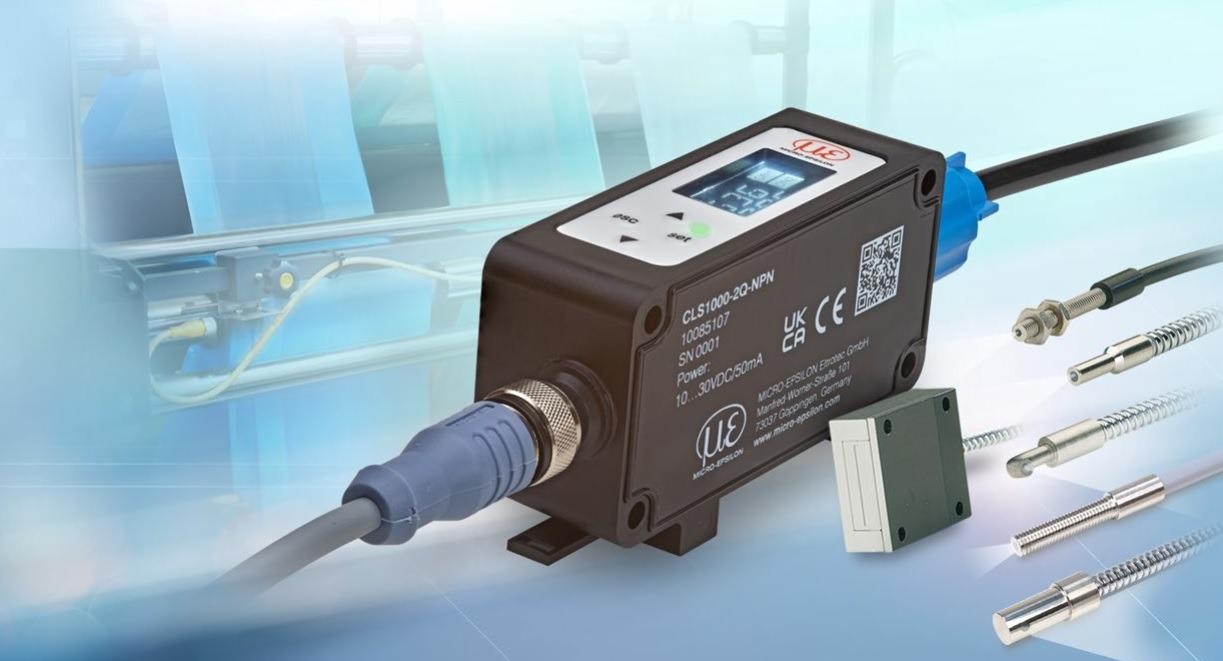Precision sensor manufacturer Micro-Epsilon has introduced an optoelectronic fibre optic sensor solution for reliable position control and presence detection in a wide range of industrial automation and process control applications.
 The new optoCONTROL CLS1000 fibre optic controller and optoCONTROL CFS range of fibre optic sensors are ideal for a wide range of industrial automation applications. Image Credit: Micro-Epsilon
The new optoCONTROL CLS1000 fibre optic controller and optoCONTROL CFS range of fibre optic sensors are ideal for a wide range of industrial automation applications. Image Credit: Micro-Epsilon
The new optoCONTROL CLS1000 optoelectronic system consists of a controller and a sensor (sensor head and glass fibre optic cable). A wide variety of fibre optic sensor heads and cables are available. Fibre optics are offered in different form factors and with focusing lens options, which means the optoCONTROL CLS1000 system can be adapted to operate in a wide variety of demanding applications and environments, including high temperatures, aggressive chemicals, vacuums and for the detection of very fine structures.
The optoCONTROL CLS1000 controller comprises of a compact transmitter and receiver unit with integrated signal evaluation. The infrared light is transmitted to the object and back via a high quality glass fibre optic cable that works on the principle of total reflection. The received light intensity is used for evaluation.
Due to their large sensing range of up to 2000 mm, the sensors can detect components at great distances. The controller also has an extremely high resistance to ambient light of up to 50,000 lux, which increases process reliability when used in production plants and systems where intensive lighting is required.
With a robust, compact design, the optoCONTROL CLS1000 is particularly suitable for use in confined installation spaces on machines, robots and production lines. The controller has an OLED display for fast, easy configuration and parameter set up. All programming steps, status displays and set/actual values are visualised via two 4-digit digital displays. The optoCONTROL CLS1000 has numerous teach-in methods including switching output functions, on/off delays, pulse output and adjustable hysteresis.
Five Controller Versions
The optoCONTROL CLS1000 controller series is available in five versions:
- CLS1000-QN with antivalence function (normally open/normally closed).
- CLS1000-2Q with two independently adjustable switching outputs.
- CLS1000-OC with optocoupler output for potential free-switching and Galvanic isolation of the output circuitry.
- CLS1000-AU with voltage output (freely scalable analogue output voltage from 0…10 V).
- CLS1000-AI with current output (freely scalable analogue output current from 0…20 mA or 4…20 mA).
Each version is available in NPN, PNP or push-pull versions, each with or without trigger.
Fibre Optic Sensor Range
The optoCONTROL CFS range of fibre optic sensors (sensor heads and cables) can be adapted to meet customer-specific applications. Special types of sensor are available for reflex (one-way) mode, reflex mode V-arrangement (two-way system), transmission mode (two-way system), and multiple reflex mode (transmitting and receiver units are statistically mixed in two or more separate sensor heads).
A range of cable sheaths (e.g. PVC, metal, Silicone-metal, VA stainless steel) are provided in various fibre bundle diameters (0.6 mm to 3 mm), lengths (0.3 m up to 2.4 m) and aperture angles. Special versions of the sensors are available with increased vibration resistance (VS), special bonding for high temperatures (T250/T400), and pressure-tight variants with vacuum feed-through (up to 10-5 mbar).
Sensor heads are available as straight output, 90-degree output for confined installation spaces, with wide light band, with and without external thread, or as thin sensor heads with bendable head.
Glenn Wedgbrow, Business Development Manager at Micro-Epsilon UK comments: “The optoCONTROL CLS1000 controller and CFS range of fibre optic sensors can be adapted to suit many different measurement tasks, from position, area, shape and presence detection, to fill level monitoring, web/film edge detection, distinction of size and diameter, tolerance checks, and for surface inspection of roughness. The high quality glass fibre optic sensors ensure reliability measurement results, even in demanding environments.”